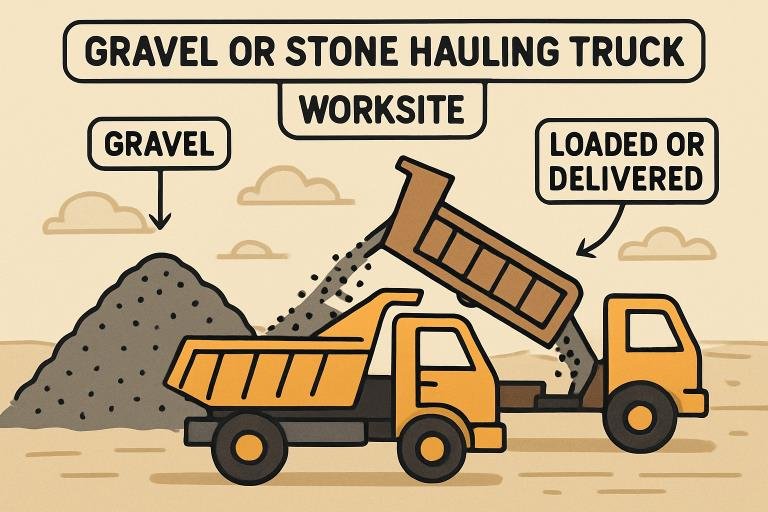Key Takeaways
- Utilizing specialized equipment like linear crushers streamlines gravel road maintenance and handling.
- Optimized routes and accurate vehicle selection reduce fuel, time, and overall costs.
- Strict adherence to regulations and weight limits ensures legal and safe operations.
Moving gravel and crushed stone from extraction sites to destinations like construction sites or roadways is fundamental to countless projects. As demands for efficiency and safety increase, the need for a reliable gravel trucking company capable of adapting to today’s expectations is more vital than ever. Proper strategies and advanced equipment ensure that materials arrive on time and that project budgets and regulatory requirements are consistently met.
Choosing the right provider and approach is key. The efficiency of your hauling operation determines how quickly, safely, and cost-effectively you deliver necessary materials. Professional companies leverage a combination of skilled teams, advanced vehicles, and technological tools to optimize every stage of the process, reducing delays and operational hiccups.
From rough terrain quarries to dense urban sites, the challenge lies in maintaining productivity while adhering to strict safety and regulatory standards. Incorporating proven practices—like specialized crushers or advanced vehicle scheduling—minimizes risks and prolongs the lifespan of roadways and critical infrastructure.
In this guide, you’ll discover the most effective strategies for hauling gravel and crushed stone. Whether handling a significant infrastructure project or local road maintenance, these methods can help you streamline operations and maximize value. For those interested in expert solutions scalable to any job size, gravel hauling services provide an all-in-one approach while maintaining compliance and efficiency.
Utilizing Specialized Equipment
Specialized machinery is a cornerstone of modern gravel and crushed stone hauling. Linear crushers and other advanced roadbuilding equipment can break, process, and lay down stone in a single pass, helping contractors and county crews slash labor time and material waste. Investing in or hiring equipment that maximizes productivity on the first go-around minimizes site traffic and reduces maintenance needs.
Consider how counties have drastically improved gravel road efficiency by using linear crushers. These machines crush rocks and distribute the material across the roadbed, creating a uniform layer without multiple machines or crews. Such innovations illustrate how targeted equipment dramatically improves results and cost-efficiency.
Optimizing Haul Routes
Hauling efficiency hinges on thoughtful route planning. The shortest distance isn’t always the quickest or most cost-effective when considering traffic patterns, road grades, and urban congestion. For example, one Maryland quarry relocated its primary crusher to reduce the distance loaded trucks needed to travel, allowing for mostly downhill hauls and saving substantial fuel and labor costs.
Effective optimization doesn’t stop at route planning. Scheduling trips to avoid congested areas, poor road conditions, or weight-restricted routes can prevent unexpected delays and operational interruptions, keeping projects timely and within budget.
Selecting Appropriate Vehicles
The right vehicle makes a significant difference in gravel and stone hauling. Articulated dump trucks, designed for rough and uneven terrains, are ideal for off-road construction hauling and reduce the risk of breakdowns or accidents on challenging sites. For paved routes or longer highway drives, specialized trailers and semis improve speed and minimize vehicle and roadway infrastructure wear.
Understanding each vehicle type’s payload limits and maneuverability is essential for safe and legal transport. Articulated trucks, for example, are built to handle large volumes with greater balance and fuel efficiency than traditional rigid trucks.
Adhering to Weight Limits
Protecting roadways and preventing hefty fines requires attention to local and state weight limits for trucks, particularly on bridges and rural infrastructure. Regularly check posted guidelines and be proactive about route planning for oversized hauls. Even well-maintained roads can suffer severe damage from overloaded trucks, leading to liability issues and injury risks.
Load management best practices, including onboard weighing systems and automatic notifications for suspected overload, are now standard for fleets working under tight regulations. This proactive approach avoids penalties and protects critical public assets and worker safety.
Complying with Traffic Regulations
Safety and compliance go hand in hand for gravel and stone haulers. Local, regional, and federal regulations are in place to reduce risks to your crew and the surrounding community. This means securing proper permits, scheduling deliveries during permitted hours, and observing all posted signage regarding vehicle size, speed, and materials.
Keeping current on legal requirements saves time and money in the long run, as violations can result in delays, fines, or even halted projects. Consulting with local transportation authorities can clarify any questions regarding specialized permits needed for larger shipments.
Timing Trips Wisely
Intelligent scheduling helps avoid the pitfalls of peak-hour traffic, road closures, and weather hazards. Planning loads for early mornings or evenings can reduce travel time and ensure safer conditions for drivers and equipment. Many municipalities provide online resources for real-time traffic updates and recommendations for commercial vehicles, making up-to-the-minute adjustments possible.
Recognizing the benefits of off-peak hauling is increasingly essential for high-output sites near urban developments. Early or late runs can be coordinated with municipal guidelines to avoid disrupting local communities.
Leveraging Technology and Tools
Modern technology, such as GPS route planning, real-time traffic monitoring, and fleet management software, optimizes logistics and improves overall hauling efficiency. These solutions provide live updates about traffic bottlenecks and road conditions, ensuring haulers can adapt instantly and reroute as necessary.
Adopting digital inventory and scheduling tools means that dispatchers and drivers stay aligned, decreasing the risk of material shortages or overbooking. As supply chain management evolves, these solutions are considered integral for companies aiming to minimize downtime and maximize throughput.
Conclusion
Implementing these efficient hauling methods for gravel and crushed stone directly impacts the success of construction and infrastructure projects of all sizes. By prioritizing specialized equipment, optimizing routes, choosing the right vehicles, respecting legal limits, and embracing modern technology, professionals can deliver on time and under budget while remaining compliant and safe.



